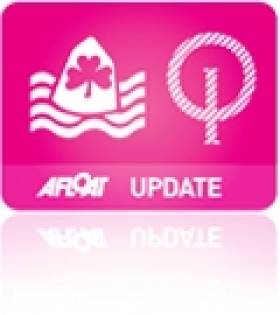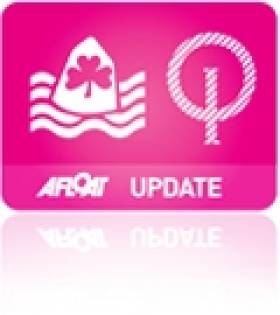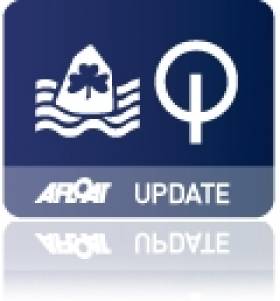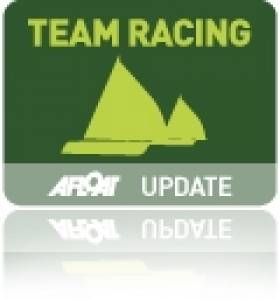Displaying items by tag: Optimist
Howth Yacht Club Drone Captures Optimist Dinghy Championships
#optimist – The Optimist class will be team racing in the waters off Howth Yacht Club this weekend competing against each other to get a winner of the VP Trophy with races umpired by national & international race umpires writes Jill Somerville. This event is organised by IODAI & HYC together.
The Vice President's Trophy was inaugurated in 1986 and has been running on and off for the past 29 years. The trophy & event was created by Helen Mary Wilkes who at the time of inception was the Vice President of the world governing body for Optimists, IODA.
Helen-Mary and Robert Wilkes have been the driving force of Under-16 sailing globally. Their contribution to the global development of junior sailing has been immense and was recognized by ISAF a number of years ago when at the ISAF Council meeting in 2008, President of the International Sailing Federation, presented the ISAF President Development Award to Helen-Mary WILKES and Robert WILKES for their services to junior sailing.
Initially specializing in event organisation, Helen-Mary Wilkes became Vice-president of IODA in 1985, President from 1989-1998, Vice-President of Honour from 1998-2005. Helen-Mary & Robert Wilkes have been involved with the Optimist class for over 35 years and here in Ireland the IODAI class benefited considerable from Helen-Mary's vast experience.
She developed the VP Team Racing event which is a club event for Optimist sailors with at least one sailor of each gender on the team. Teams are made up of 4 sailors from the one club and for the 2015 event there are 8 teams entered. A schedule of 28 round robin races have been drawn up with each of the teams due to sail against every other team and then the option of a semifinals & finals weather & time dependent. Key clubs in the Optimist scene such as HYC, RCYC and R.StGYC and the IODAI world's team will all fight it out on Sat 13th in waters off HYC. There will be good viewing from Aqua restaurant or the pier in Howth. The wining club team will head to the Optimist European Team Racing Championships in Aug in Ledro Italy. Race Officers Neil Murphy & Richard Kissane will be hoping for a little more wind than is currently forecasted to get through the heavy race schedule and we hope to have a winner declared late on Saturday afternoon. IODAI wishes good luck & fair sailing to all in the event.
#optimist – Howth Yacht Club's Harry Bell was the winner of a cut–short Optimist Ulster Championships at Ballyholme Yacht Club yesterday. Like other east coast sailing events Satuday's schedule was blown out and three races were sailed on Sunday. Lough Derg Yacht Club's Sarah Levie was second in the 32–boat senior fleet and third was the Royal St. George's Hugh Kennedy. Results for the senior, junior and regatta fleets are downloadable below.
#optimist – Optimist dinghy ace Micheal O'Suilleabhain of Kinsale Yacht Club took a well earned win on home waters yesterday with a ten–point margin in the senior fleet after six races sailed at the Munster championships. The 13–year–old beat the Royal St. George's Tom Higgins with Howth Yacht Club's Jamie McMahon third in the 41–boat main fleet. In the junior fleet 12-year–old Robert Keal beat club mate Harry Twomey in a one–two for Royal Cork Yacht Club. Results for both fleets are available to down laod below as jpeg files.
The Optimist Munsters had an excellent entry of 36 boats in the Regatta fleet, all very enthusiastic and rearing to go in the excellent conditions prevailing on Saturday. They sailed against the magnificent backdrop of Charlesfort and, with the promise of more wind for Sunday, the Race Officer got in four races on the day. The very active youngsters came ashore tired but vey satisfied with their day and looking forward to enjoying some time in Kinsale but aware of the fact they had to be rigged and ready to go to sea at 9.30am on Sunday.
Following all this activity the young competitors set about tidying and packing away their gear in preparation for the journey home. The Regatta prizegiving was held separately from the Senior and Junior fleets. Some of the regatta sailors and their families were then able to leave early for the journey home to various parts of the country with a large contingent heading for Dublin.
Others had older brothers and sisters sailing in the two higher fleets and they were able to enjoy themselves around the club facilities while waiting for the second prize giving to finish.
#royalcork – The Organisers of August's Cork Dinghy Fest 2015 have introduced an Optimist fun fleet to this year's event. This fleet is for the sailors that do not qualify for the main optimist fleet. The Royal Cork Yacht Club idea is that this fleet will take part in some point to point fun races, like a race around Spike Island or a race up the Owenabue River at high tide. The young sailors will also be involved in fun shore side activities if the weather does not permit them to take to the water on any given day. This is seen as a great way to include as many sailors as possible in the festival without compromising the racing of the other fleets.
The new format dinghy week runs from 20th – 23rd of August.
The main Optimist fleet has also been limited to the first fifty entrants. Sailors must be ranked in the top fifty, from their Junior or Senior National rankings 2014.
Event plans are now well under way and it is shaping up to be a unique sailing experience, with four main race areas as well as two point to point race areas.
Here is a quick look at what's on, according to the RCYC:
1. Fun activities for all after sailing, (Stand up paddle board races, adult Optimist racing etc.)
2. Aprés sail music,
3. Anto's Famous BBQ.
4. Special guest speakers,
5. Dinghies on display.
6. Invitational sailing by other classes after racing.
7. Tidal Briefing for the next day on each race area.
8. Night time bands and DJ's.
9. Dedicated camping
Youth Sailing Thrills As Strong Winds Sweep Cork Harbour
#youthnationals – There were thrills and spills galore at Royal Cork Yacht Club today (Saturday) in the penultimate day of the Irish youth sailing national championships writes Claire Bateman. The ebb tide flowing out of the Eastern Bank in Cork Harbour and the opposing forces of the W/S.W wind gusting up to 26 knots made for difficult conditions for the ISA pathway sailors. Indeed so much so that the Laser 4.7s and Toppers had to make do with just one race before they were towed home. Meanwhile the Laser Radials and the 420s had an exhilarating day of racing but racing for the 420s was abandoned before Race 4 and the Laser Radials completed three races.
To quote Rory Fitzpatrick, Youth Performance and Development Manger: "I was out with the 420s and Laser Radials today and the whole fleet was incredibly impressive. The way they handled the exceptionally difficult conditions demonstrated clearly that these dedicated sailors have spent some considerable hours in their boats". It also has to be said that it is to the credit of the Race Officer for these two fleets, Alan Crosbie, that great concern for all the competitors was his primary objective and to see that all who were retiring or capsized were accounted for. He had a mother ship and rescue standing by. He was also heard on radio instructing all rescue and support RIBS to be alert to the fact there was another squall on its way. It brings your scribe back to one day some moons ago when he was dealing with a fleet of bucking bronchos all being skittish at the start of a race and the dulcet tones came over the radio saying "I'm watching you, they are watching you from the pin end and God is watching you from above". Today the dulcet tones came over the radio again to advise "this will be a black flag start as we have no time for messing today".
On the Optimist course as one approached the fleet in the morning, several competitors, prior to racing, went off on a reach and loud whoops of delight could be heard as the youngsters surfed the waves, here again under the watchful eye of the rescue RIBS. Once again, they sailed a longer day than any other fleet getting in another four races. One has to really admire the determined grit of these young sailors. Every inch of the Curlane Bank was utilised to day to give these youngsters the longest beat possible.
Forecast for tomorrow (Sunday) is for more strong wind and hopefully racing will be able to take place.
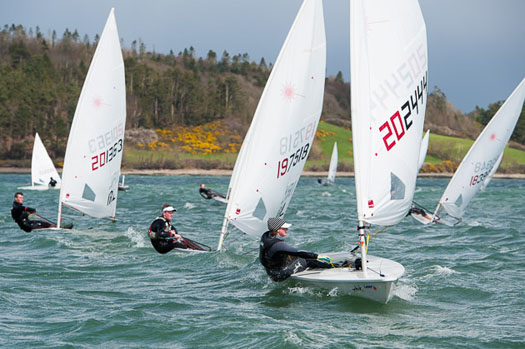

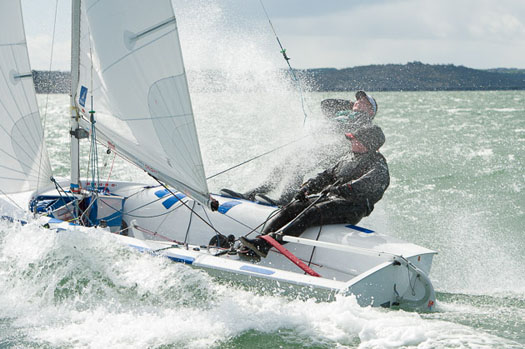

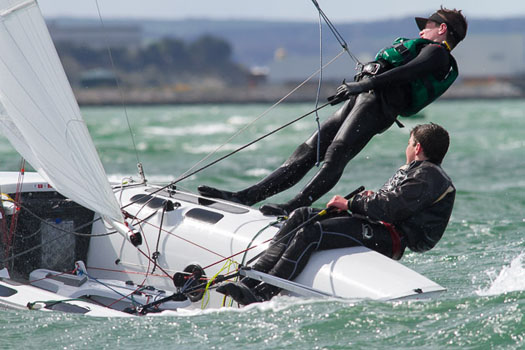
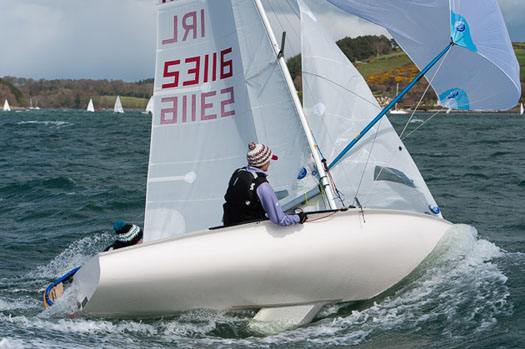
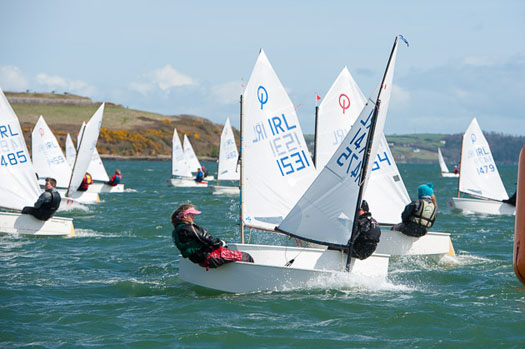
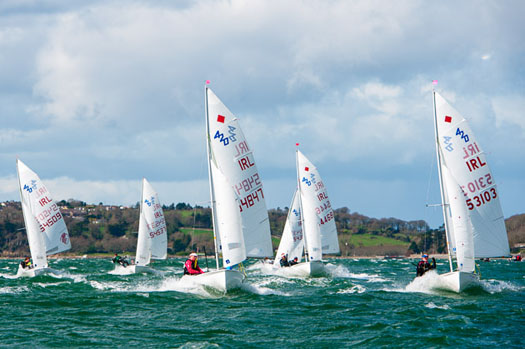

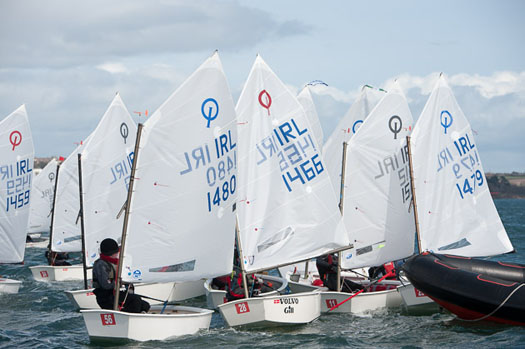





Competition Intensifies at Youth Nationals and Optimist Trials
#youthnationals – The Irish Sailing Association (ISA) Pathway Youth Nationals 2015, taking place at Royal Cork Yacht Club are in their second day of competition at Crosshaven writes Claire Bateman. Topper, 420, Laser 4.7 and Laser Radial classes are competing in selection trials for National squads and potential selection for the National Academy. The four-day event also sees the International Optimist Dinghy Association Ireland, 2015 Optimist Trials take place with over 60 entrants.
Today began as a foggy grey day with the breeze more from the south and with a fitful sun trying to break through the clouds like a patchwork quilt on the water later in the day. The wind also increased at this stage going to 16 to 18 knots with a slight hint of west in it. A third Race Committee was called to action under the highly experienced Race Officer David O'Brien of Royal Cork for the 4.7s and the Toppers who were commencing racing today. To a person doing a tour of the three race areas, looking at racing with inner loops and outer loops, separate finish boats, on the water Juries blowing whistles signaling to the unwary, or possibly not unwary, that they had infringed the rules, it all appeared a very competent and slick operation timed to the last. The race team for the 420 and Radials moved further east on the Eastern Bank opposite the Aghada Sailing and Tennis Club where they had to wait a little bit longer for the wind to reach them. When it did it was great to see these fleets surfing on the waves.
In the 420 Class Peter McCann and crew Harry Whitaker from RCYC are the current leaders, followed by Douglas Elmes and Colin O'Sullivan, RCYC/ HYC, while the younger McCann brother James and crew Bill Staunton, RCYC, are in fourth place with Lizziy McDowell and Anna O'Regan from MYC taking the third spot..
In the Laser Radial fleet after six races and one discard Conor Beirne RStYG leads Erica Ruigrok from Rush SC in second followed by Cian Byrne from the host Club in third place.
Meanwhile the 29 boat Topper fleet, having sailed three races, are now led by Geoff Power WHSC, followed by Luke McElwaine from Carlingford Lough, tied on points but with count back putting McElwaine in second place and Caoimhe Foster RCYC taking the third spot.
In the 30 boat Laser Radial Fleet Richard McGinley of the Host Club leads from Ross Morgan SSC, second followed by Rebecca O'Shaughnessy, RCYC 3rd.
In the Optimist 60 boat fleet with Ireland's top sailor Anthony O'Leary as Race Officer the fleet sailed on a traditional Optimist course and had a long day sailing four races bringing their total to seven to date on this weekend which is an Optimist Trials Event confined to sailors who qualified at regional events and the Nationals in 2014. Current leader is Tom Higgins, RStGYC, followed by Gemma McDowell, MYC and Harry Bell, HYC third.
Racing continues tomorrow (Saturday) and tensions are now mounting at this stage of the weekend. Forecast is for fresher conditions and some exciting sailing should be seen throughout the fleets.
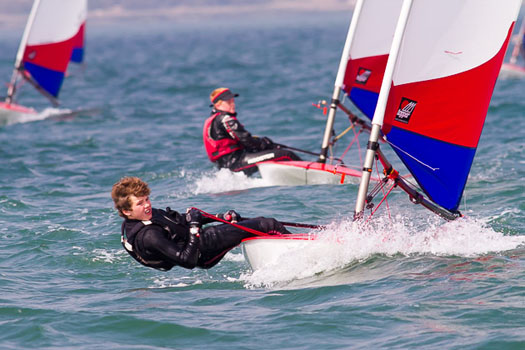
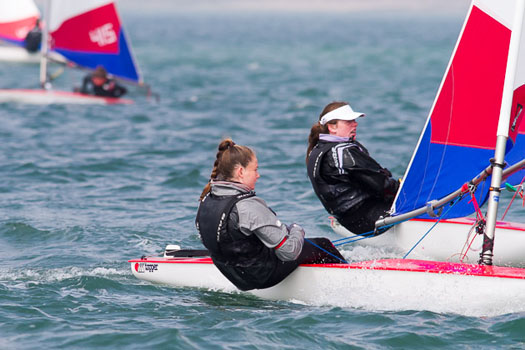
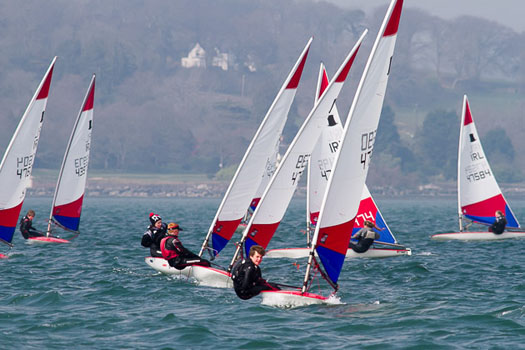
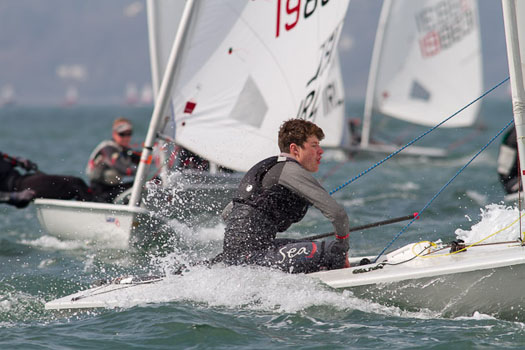
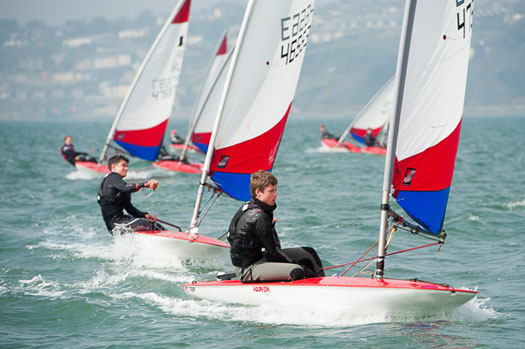
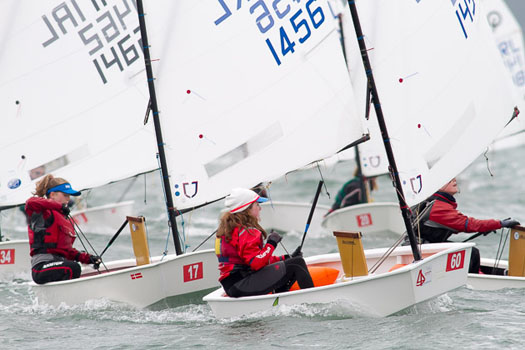
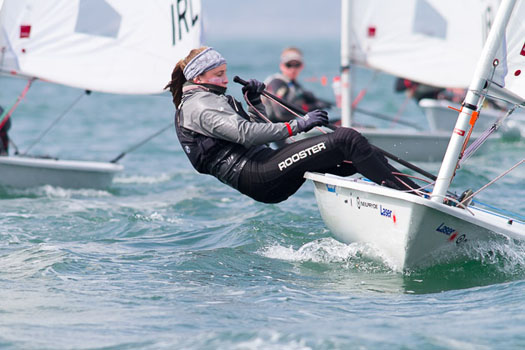
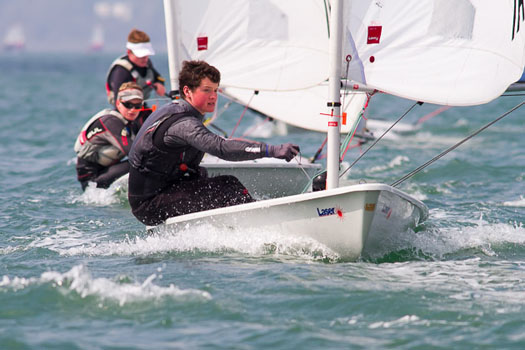
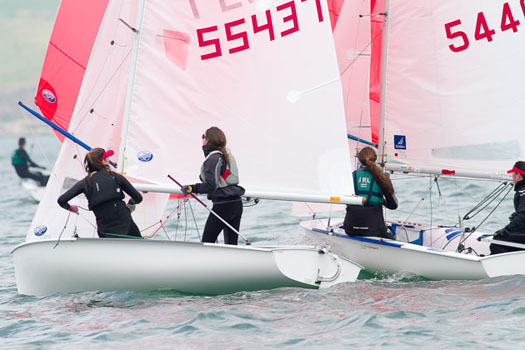
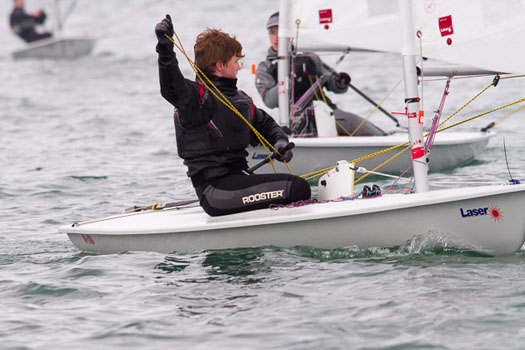
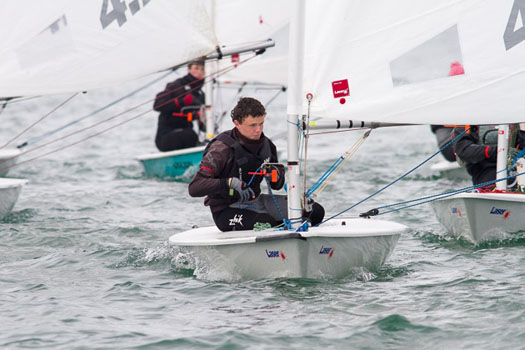
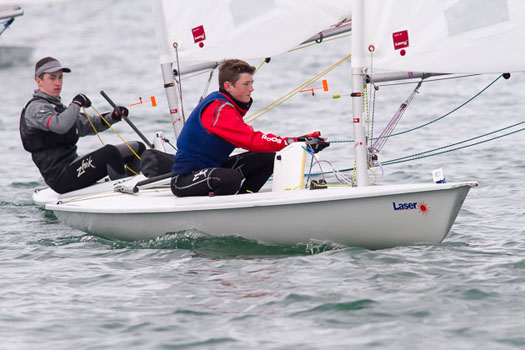



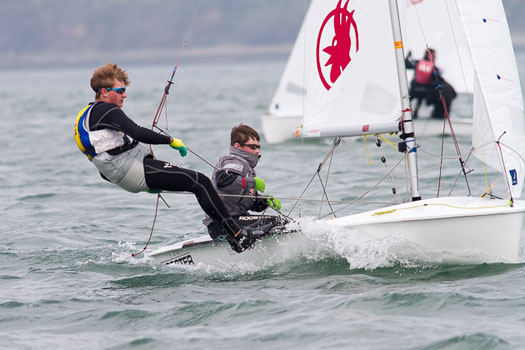
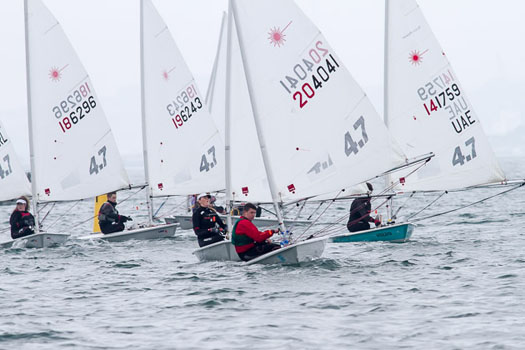

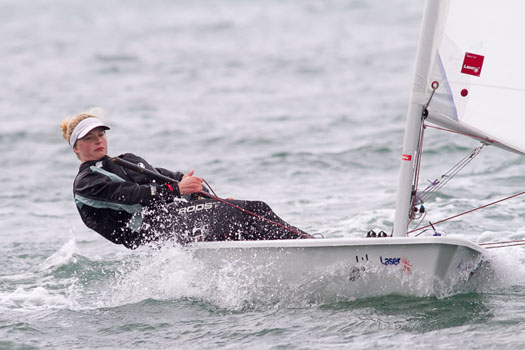
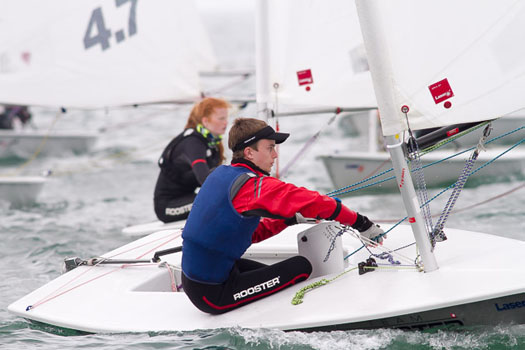
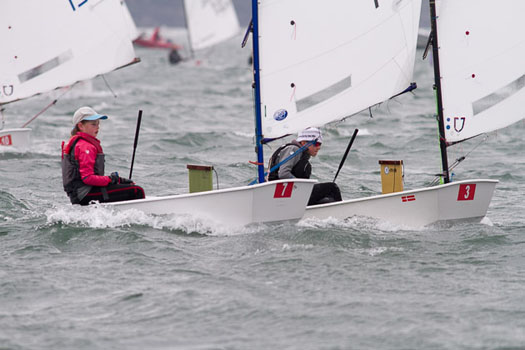
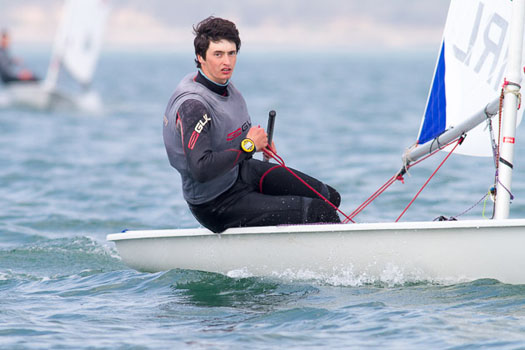
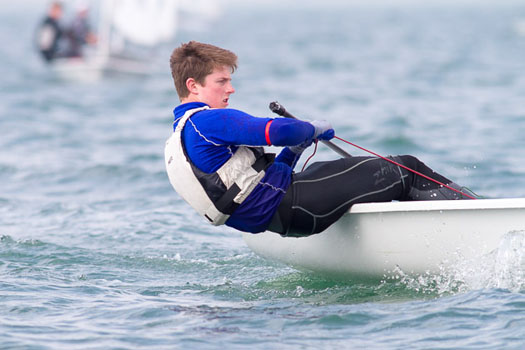


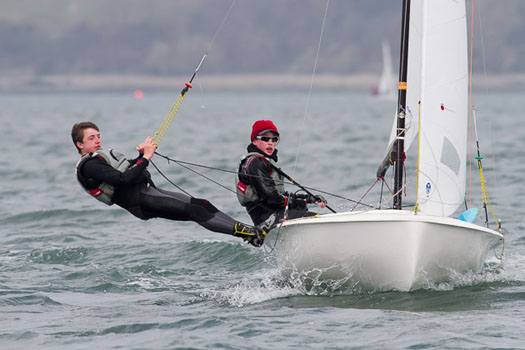
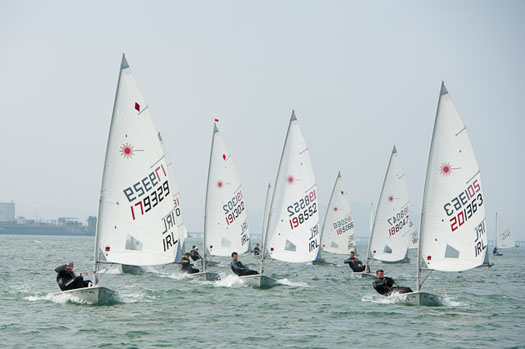

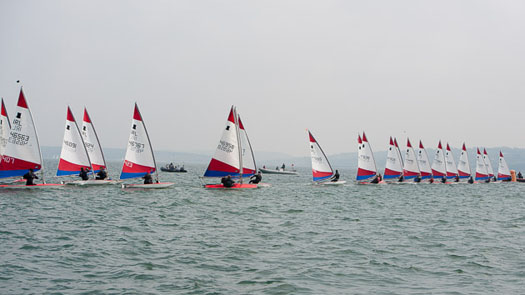
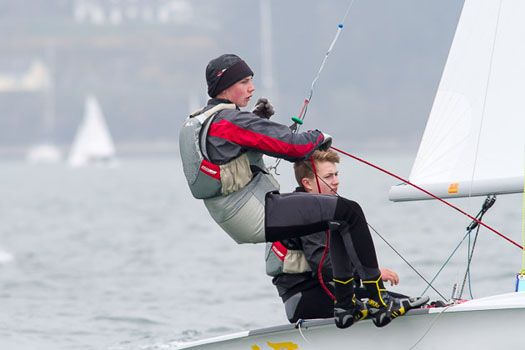

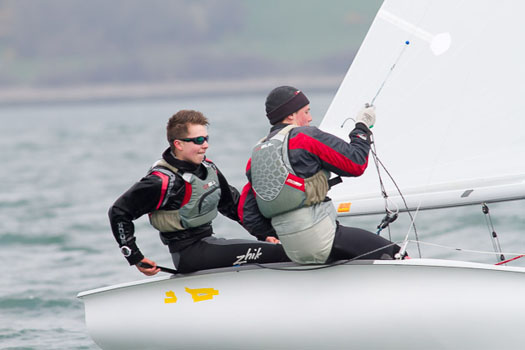
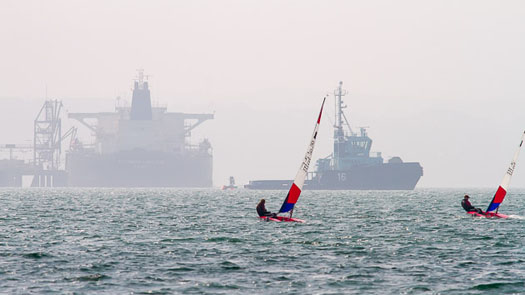
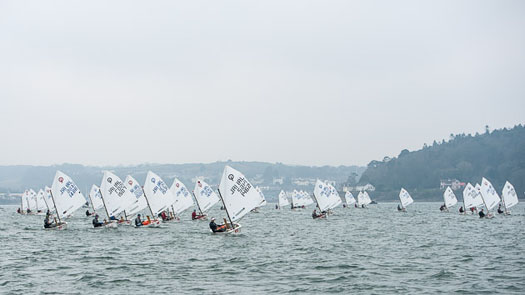
#optimist – Last weekend saw Howth Yacht Club host their annual Brassed Off Cup regatta for the Optimist dinghy class. The event which is traditionally held on Good Friday was postponed until the following day as a cold & blustery north-westerly wind blasted down the race course for the day. And what a difference a day made, as Saturday was truly summerlike with warm sunshine and a gentle breeze.
Race officer Jim Lambkin & his team managed to get three good races in before the light NW breeze died away. The racing was tricky with slow & difficult beats against a strong ebbing tide. It became a case of the 'rich getting richer' with the first few boats to round the weather mark quickly stretching out from the fleet behind.
In the Senior fleet, the Dun Laoghaire boats revelled in the light & tortuous conditions. Jack Fahy (RSTGYC & LDYC) managed to squeeze out Clare Gorman (NYC) for 2nd, but it was to be Hugo Kennedy's day (RSTGYC). Hugo won the event convincingly with two bullets and a third and got to take the Brassed Off Cup home.
The Dun Laoghaire boats reigned supreme again in the Junior Fleet with Conor Gorman (NYC) taking gold after winning two races and coming second in the last. Alana Coakley (RSTGYC) took silver and HYC's Luke Turvey restored some dignity to the host club by taking bronze.
The Regatta Fleet was closely fought by local sailors Johnny Flynn & Alice Lacy. They got a big jump on the fleet by being the only two to finish the first race. They ended tied but Johnny took gold as a result of having bagged two firsts. Elysia O'Leary (RSTGYC) took third overall.
Forum For Irish Team Racing Discussion Opens Online
#teamracingforum – News that the Optimist dinghy class in Ireland is once again organising a team racing event, together with the announcement of plans for junior event in the Royal St George and the continuing development of 2K team racing in Europe confirm that team racing offers competitive sailing for all ages. With this new impetus the Irish Team Racing Association have set up a forum to allow 'in depth discussion' of a large number of topics regarding team racing and its development in Ireland.
The forum is reserved for active participants in team racing organised by ITRA. Delegates from IUSA, the Irish National Schools Sailing Association will be invited to participate if they do not qualify for access directly. As membership of ITRA is one topic that needs to be addressed access to this forum is limited to sailors, race committee and umpires who took part in the ITRA Nationals in 2013 and 2014.
The forum registration process is here
Is Being an Olympic Sport Good for Irish Sailing?
#olympicsailing – Water Rat's article: Is ISAF Alive To Sailing's Survival As An Olympic Sport? has raised the issue about the future viability of the Olympic sailing movement and brought reaction from readers, including Midshipman, who says it begs two interesting questions:
· Is being an Olympic sport good for sailing?
· Why have the amazing advances we have witnessed in technology over the last 15 years not made sailing more accessible and less expensive?
With the exception of the Laser (a manufacturer controlled boat which is not cheap at €7,250), none of the boats used in the Olympics are to be found in mainstream sailing.
The explosion in sailing during the 60's and 70's was fuelled by the development of exciting low cost boats built, mainly by amateurs, in plywood using new adhesive and coating techniques.
The turn of the century has seen vast improvements in the technologies used in boat building, making boats lighter, faster, stronger safer, but certainly not cheaper, as amateur construction can no longer compete with the sophisticated techniques of the boating industry.
That is probably why the most popular dinghy class in the world remains the inexpensive and simple Sunfish while low tech Hobie Beach Cats still dominate the multihull scene.
In years gone by, most young sailors got their start in wooden Optimists, often built by enthusiastic parents at modest cost over a couple of weekends and then typically graduated to a home built Mirror or its equivalent for their first experience of multi crewed sailing with multiple sails.
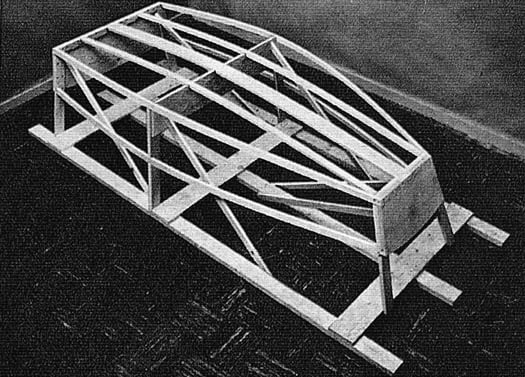
A wooden framework of the early Optimist dinghy
Nothing less than a relatively expensive Glass Fibre Optimist will do now and the Street Cred of young people is dependent on graduating to costly Lasers and 420s. In Ireland this situation is also compounded by the sense of failure youngsters experience if they fail to qualify for one of the Academy or Elite development squads which currently involves over 100 youth sailors of varied abilities.
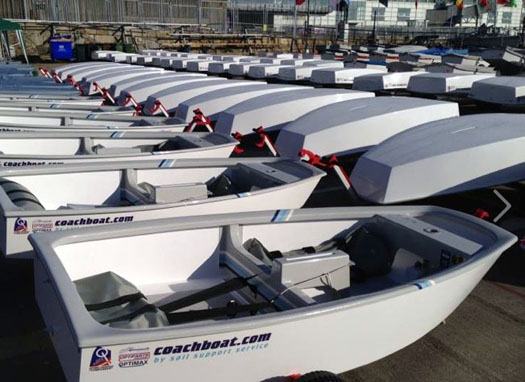
The scene today – charter boats used at Dun Laoghaire for the 2014 Optimist Europeans
Sailing has become so fixated on exciting performance and elite achievement that it has lost sight of the sheer enjoyment of messing about in boats at modest cost which is the principle attraction to the vast majority of people.
We all admire the highly skilled and motivated sailors who aspire to the ultimate Olympic challenge, but let's face it , what they do has virtually no relevance to the activities of most recreational sailors. ISAF uses racing formats and boats which are not reflective of the sport in general, largely on the grounds of needing to excite TV viewers.
With the exception of horse riding, sailing is probably the most equipment dependent (meaning most expensive) sport in the Olympics. I am not sure that this is a message which ultimately helps encourage people to become involved in sailing.
If we want to use the Olympics as a marketing opportunity for sailing, we should use inexpensive boats which are used on a widespread basis by regular sailors and only have 2 events each for men and women whilst eliminating the cost of shipping boats by supplying evenly matched equipment.
Olympic sailing has created a very costly industry which contributes little back to mainstream sailing. The costs are truly horrendous as demonstrated by the recent announcement that the ISA is appointing an additional CEO to head up a funding programme to raise a further €2.75m a year over and above the €1m plus it receives from the Irish Sports Council for Irish Elite sailing activities.
Does the Irish sailing community believe an annual level of expenditure of €3.75m on elite sailing provides the best economic payback to the sport in Ireland? If we could replicate what has been done in New Zealand, maybe there is a business case which can be justified.
However, €15m seems an outrageous amount of money to propose spending over an Olympic cycle, which is equal to something in excess of €800 on behalf of each member of the ISA.
Let's make sailing accessible, less expensive and more engaging and use the Olympics as a shop window to remove the elitist and esoteric imagery created by the current profile of existing Olympic classes.
What we are doing at the moment is deluding ourselves into believing that presenting our sport like NASCAR or Formula 1 motor racing will attract new people to buy Ford Mondeos and Fiat Pandas. – Midshipman




























